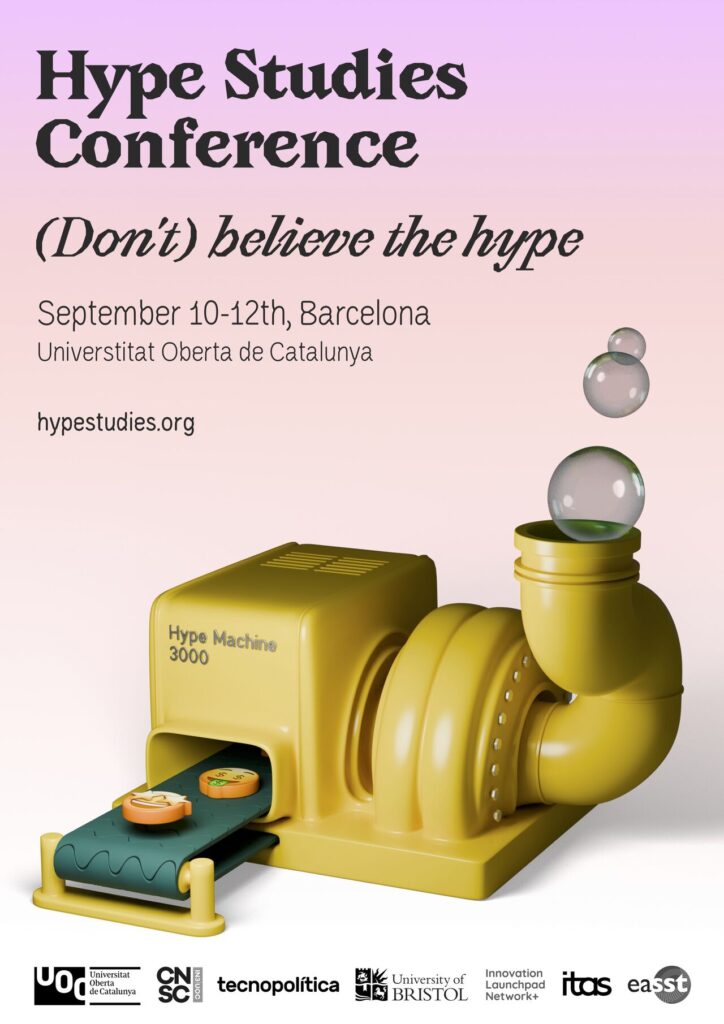10-12 September 2025, Open University of Catalunya
Hype is a powerful and pervasive phenomenon that influences economic trends, political agendas, media narratives, and technological development. It creates momentum, attracts investment, and fuels speculation, while simultaneously distorting reality, misallocating resources, and amplifying uncertainties. Hype is not just an exaggeration—it is a dynamic process that plays a crucial role in contemporary societies, shaping decision-making at multiple levels.
The Hype Studies Conference: (Don’t) Believe the Hype, to be held at the Open University of Catalunya between the 10th and the 12th of September 2025, aims to examine hype as a performative force, exploring its mechanisms, effects, and implications across different domains. From the speculative visions of emerging technologies to political rhetoric, from financial bubbles to cultural trends, we seek to understand how hype operates, who benefits from it, and how it transforms the social, media, political, economic and technological landscape. This conference is partly supported by the EASST fund.
The conference is structured around three tracks:
Concepts and Characteristics. How can we define hype in contrast to rival concepts found in academic and media discourse? What distinguishes hype from imaginaries, trends, alarmism, visions, expectations, or futures?
Dynamics and Temporalities. How can hype be read, studied, assessed—or even anticipated? When and where does it emerge? What can linguistic, narratological, artistic, historical, ethnographic, statistical, bibliometric, or discourse-analytical approaches contribute to the study of hype?
Engaging. How do practitioners and artists depict, experience, produce, and navigate hypes? This track includes discussions on debunking, myth-busting, fact-checking, and training in journalism, science and technology communication, artistic interventions, and more.
These tracks will be explored through three types of formats:
Panel Presentation. Traditional academic panels presenting new research or insights into a topic, theory, initiative, or project and its background.
Open Floor. A curated discussion space where two or more participants engage in a dialogue on a topic, concept, project, or event. This format is interactive and participatory, encouraging audience involvement.
Making and Doing. Action-research projects, workshops, activist interventions, games, video art, and other experiments will be shared either as installations, performances, or screenings at the conference venue. Participants may also pitch alternative, inspirational formats.
The conference brings together researchers, journalists, students, artists, designers, policymakers, technologists, consultants, and communication professionals to reflect on the nature of hype and its sociotechnical effects.
The Hype Studies Conference: (Don’t) Believe the hype receives kind financial support by the EASST fund, as well as
- Universitat Oberta de Catalunya / Communication Network and Social Change / Tecnopolítica (partly funded by the project 2021 SGR 01397, Departament de Recerca i Universitats, Generalitat de Catalunya).
- Institute of Technology Assessment and System Analysis – Karlsruhe Institute of Technology
- Bristol Digital Futures Institute
- Engineering and Physical Sciences Research Council’s Innovation Launchpad Network+ Researcher in Residence scheme (grant numbers EP/W037009/1, EP/X528493/1).
- Maastricht University
